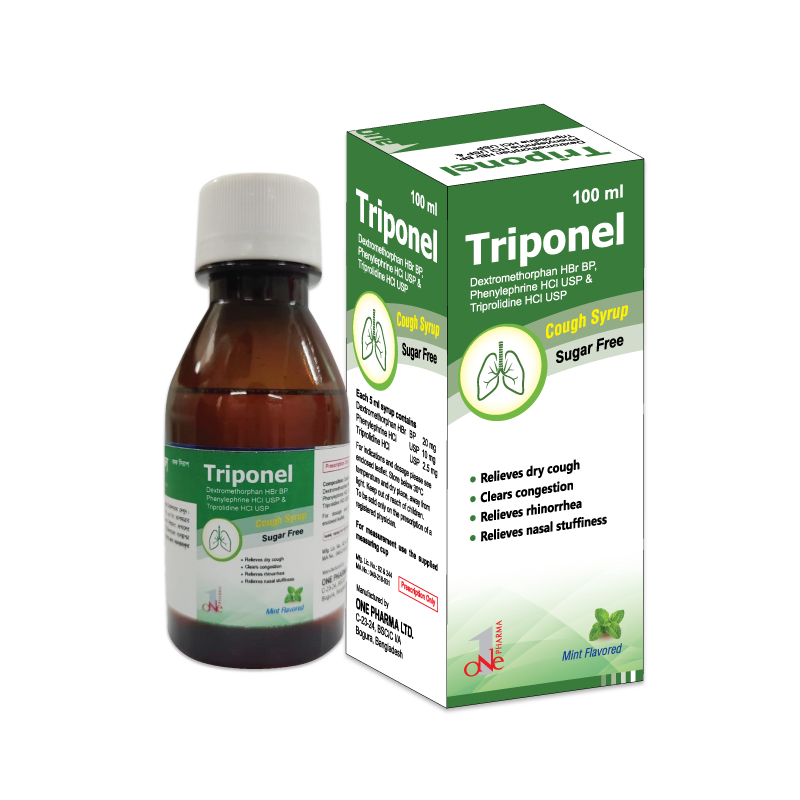

Composition
Triponel Syrup: Each 5 ml syrup contains Dextromethorphan Hydrobromide BP 20 mg,
Phenylephrine Hydrochloride USP 10 mg and Triprolidine Hydrochloride USP 2.5 mg.
Pharmacology
This preparation is a mixture of antitussive, decongestant and antihistamine agent.
Dextromethorphan is a safe, effective, non-narcotic antitussive agent which has a central action on
the cough center in the medulla. Although structurally related to Morphine, it has no analgesic and
habit forming properties and in general it has little sedative activity. Phenylephrine is a
decongestant that shrinks blood vessels in the nasal passage. It is used to treat nasal and sinus
congestion of the tubes that drain fluid from inner ear.
Triprolidine provides symptomatic relief in conditions believed to depend wholly or partly upon the
triggered release of histamine. It is a potent competitive histamine H1-receptor antagonist of the
pyrrolidine class with mild central nervous system depressant properties which may cause
drowsiness.
Indication
Symptomatic relief of upper respiratory tract disorders accompanied by non-productive cough which
benefits from the administration of a nasal decongestant, a histamine H1-receptor antagonist and
an antitussive combination.
Dose & administration
a) Route of Administration: Oral
Adults & Children over 12 years: 1 teaspoonful (5 ml) 4 times a day.
6-12 years: 1/2 teaspoonful (2.5 ml) 4 times a day.
A physician’s advice should be obtained before administering this combination to children less than 6 years.
Contra-indication
This combination is contraindicated in patients with a known hypersensitivity to Dextromethorphan,
Phenylephrine or Triprolidine as well as in persons under treatment with Monoamine Oxidase
Inhibitor within 2 weeks of stopping such treatment.
Warning and precaution
This combination may cause drowsiness. It may impair the patient’s ability to drive and also to use
machineries. Although there are no objective data, users of this syrup should avoid the concomitant
use of alcohol or other centrally acting sedatives. As with other sympathomimetic agents caution
should be exercised in patients with hypertension, heart disease, diabetes, hyperthyroidism,
elevated intraocular pressure and prostatic enlargement. This combination should not be used for
persistent or chronic cough such as occurs with smoking, asthma or emphysema or where cough is
accompanied by excessive secretion unless directed by a physician.
Side effects
a) Common: It may cause drowsiness, dottiness and constipation. Other side effects that may occur
include GIT discomfort. No apparent evidence of physical dependence of the morphine type.
b) Rare: Other less common side effects may include transient hypertension, dry mouth,
restlessness, palpitations, allergic reactions such as rashes, tightness of chest, thickening of
bronchial secretions, toxic psychosis and blood dyscrasia.
Use in pregnancy & lactation
There are no specific data on use of this combination during pregnancy & lactation.
Use in children & adolescents
This preperation is not indicated for children under 6 years of age.
Drug interaction
a) With Medicine: Taking certain Monoamine oxidase inhibitors (MAO) with this medication may
cause a serious (possibly fatal) drug interaction. Caution should be exercised while taking this drug
with antihistamines applied to the skin (such as diphenhydramine cream, ointment and spray),
antispasmodics (e.g. atropine, belladonna alkaloids), beta blockers (e.g. metoprolol, atenolol),
anti-seizure drugs (e.g. carbamazepine), medicine for sleep or anxiety (e.g. alprazolam, diazepam),
muscle relaxants, narcotic pain relievers (e.g. codeine), psychiatric medicines (e.g. chlorpromazine,
risperidone, amitriptyline).
b) With food & others: There is no data found on interaction with food of this medicine.
Overdose
In cases of over dosage, hospital admission is strongly advised. Over dosage may produce
respiratory depression, paranoid psychosis, delusions, hallucinations and convulsion. Treatment
should include emptying the stomach by aspiration or gastric lavage. Nervous stimulation and
convulsions should be treated with a sedative such as diazepam intramuscularly. If marked
excitation is present, a sedative such as diazepam or a short-acting barbiturate may be given.
Storage
Store below 30°C. Protect from light. Keep all medicines out of reach of children. Do not refrigerate
or freeze.
Packing
Triponel Syrup: Each box contains a PET bottle of 100 ml syrup with a measuring cup.